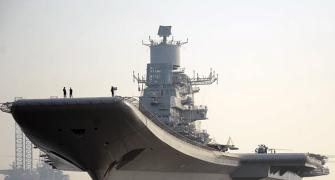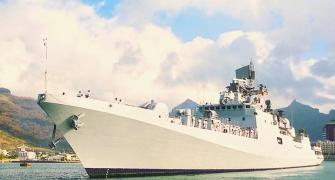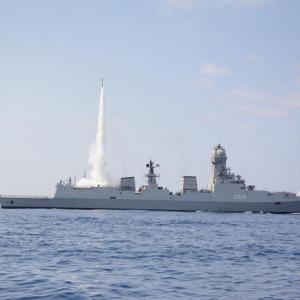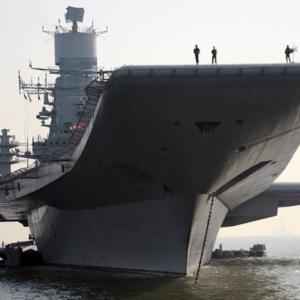The navy wants to spend Rs 40,000 crore on INS Vishal, a choice the army and air force oppose.
This is as much about turf as about funding. explains Ajai Shukla.
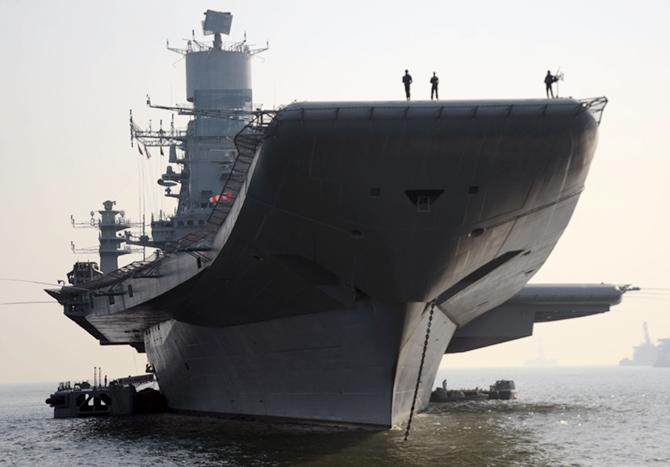
With the military short of funds for modernising its arsenal, India's most contentious and consequential weapons procurement debate is taking place over the Navy's proposal to build a second indigenous aircraft carrier -- Indian Naval Ship Vishal.
There are already two aircraft carriers -- the Russian-built INS Vikramaditya, which joined the fleet in 2013 and INS Vikrant, which the Cochin Shipyard Ltd expects to make fully operational in 2022.
INS Vishal, the third carrier, would allow the Indian Navy to operate two carriers while allowing one to be in the dockyard for repair, overhaul or upgrades.
Given the military's modest capital budget of Rs 1.18 trillion ($16.5 billion) for 2020-2021 -- which is one-fourth of the total defence allocation of Rs 4.7 trillion ($65.8 billion) -- the Indian Air Force and the army are opposed to committing a large chunk of money to a single naval procurement.
Tri-service chief General Bipin Rawat has made it clear that he too does not regard a third carrier as a priority.
'What will be its effect on the air force and the army? We have to... see the impact of the third aircraft carrier,' he said.
For the IAF, a third aircraft carrier would leave less funding for its own big priority: A $15 billion to $20 billion plan to buy 114 medium fighters.
The army similarly wants the lion's share of the capital budget to be expended on artillery guns, tanks, rifles and aviation assets such as attack helicopters.
This is as much about turf as about funding.
Air forces have historically regarded aircraft carriers as naval encroachments into their domain; which is control over all combat aircraft.
The IAF argument is that fighter aircraft, operating from well-protected shore bases, can support the navy fleet better than a handful of fighters operating from a vulnerable carrier that the enemy would be targeting relentlessly.
Navies worldwide have fought this turf battle, including Britain's royal navy.
Old salts recount when Winston Churchill, as first lord of the admiralty (the royal navy used to have its own minister!), boarded an aircraft carrier in 1939 for a day at sea.
While he was looking around, a siren blared and he found himself alone.
Making his way to the ship's bridge, Churchill asked the young lieutenant on watch what was happening.
The lieutenant pointed to the sky at a Messerschmitt 109 fighter circling the carrier. 'Enemy aircraft,' he explained.
Churchill glowered at him. 'Son, that's a Luftwaffe (German air force) fighter! Always remember: The Luftwaffe is only the adversary. The enemy is the royal air force.'
In keeping with that relationship, a spate of recent articles in the Indian media has argued against buying a third carrier.
These air power votaries have described aircraft carriers as 'white elephants', exorbitantly expensive in themselves, but also tying down a whole flotilla of escort vessels -- frigates, destroyers, logistic support vessels and submarines -- that make up a 'carrier battle group' with the firepower and staying power needed to survive and project power far from India's shores.
A linked argument is that carriers are such powerful symbols of national prestige that the sinking of one would be a damaging psychological blow to national morale.
This echoes the logic of the German navy in World War I, which shied away from sending its vaunted dreadnoughts (heavy cruisers) into battle since they were 'too big to lose'.
The air power lobby also argue that it would be rash to spend some Rs 1 trillion on the massive, 65,000-tonne INS Vishal -- with half that amount required for its aviation complement of 50 to 55 aircraft.
Instead, that money would be better spent on more usable assets, such as frigates and submarines.
The survivability of carriers is a question mark, say the air power theorists, since China's People's Liberation Army (Navy) has over the last two decades implemented a potent Anti Access/Area Denial (A2/AD) doctrine to deter any repeat of the Taiwan strait crisis of 1996, when an American carrier battle group sailed between Taiwan and China to signal support to the former.
As part of the A2/AD strategy, China has developed weapons such as the Dong Feng 21D 'carrier killer' ballistic missile that can supposedly destroy enemy aircraft carriers at ranges out to 1,500 kilometres.
The air power advocates acknowledge the fleet needs air support.
However, they say it should be delivered from shore bases, through the IAF's long-range fighters, such as the Sukhoi-30MKI and soon the Rafale, which can strike targets far in the Indian Ocean.
Mid-air refuelling would increase the reach of land-based fighters, once India concludes its long-delayed acquisition of air-to-air refuelling aircraft.
Top naval planners contest the notion of a 'Rs 100,000-crore carrier'.
A top admiral said: The "INS Vikrant, the first indigenous carrier (IAC-1) will have a final cost of Rs 19,800 crore. The defence ministry's cost c ommittee has fixed the cost of IAC-2 at Rs 40,000 crore -- twice that of IAC-1. That caters for the larger size of IAC-2 (65,000 tonnes, compared to the 40,000 tonne IAC-2). It also caters for the IAC-2's more sophisticated and expensive weaponry, and for inflation."
Crucially, IAC-2 does not need a new air wing.
The navy already has 45 MiG-29K/KUB fighters and the additional 57 carrier deck fighters currently under purchase will give the Navy enough fighters for two air wings.
A third air wing in unnecessary, since one of the three carriers is planned to be in refit at any given time.
The navy plans to pay the Rs 40,000 crore cost of IAC-2 over a decade, which averages to an annual pay out of Rs 4,000 crore.
Of the navy's current capital budget of Rs 26,688 crore, 30 per cent -- or Rs 8,000 crore -- is available for new purchases.
With the capital budget expected to rise by an annual 10 per cent, naval planners are confident they can afford the expense.
The Rs 40,000 crore projection for the INS Vishal appears realistic, when compared with what the UK paid to build two similar, 65,000 tonne, conventionally powered carriers -- the HMS Queen Elizabeth and the HMS Prince of Wales.
Together they cost 6.2 billion pounds or about 3.1 billion pounds (Rs 28,700 crore/Rs 287 billion) apiece.
The navy, long at the forefront of indigenisation, underlines the benefits of building the INS Vishal in India.
While the IAF's acquisition of foreign aircraft mainly benefit foreign corporations, the Rs 40,000 crore payout on IAC-2 will go mainly to medium, small and micro enterprises.
For example, 2,100 Indian MSMEs are working on Project 17A -- the construction of three stealth frigates at Garden Reach Shipbuilders and Engineers, Kolkata.
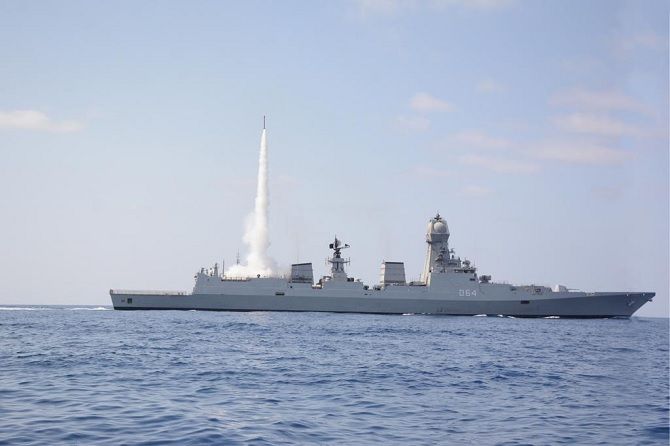
The admirals also rebut the IAF's claim that it can provide the navy adequate air support.
India's military doctrine requires the navy to project power far from our shores, as the "net security provider" in the Indian Ocean.
Establishing "sea control" far from one's shores -- for example, off Africa's western coast, or south of Indonesia -- requires "persistent" air power, which can remain in the target area.
Even if IAF fighters, operating from faraway shore bases, manage to reach the target area, they lack the endurance to remain there for any length of time.
In contrast, a carrier can keep its aircraft on deck and launch them at short notice when they are needed.
There was some merit in the IAF's contention that smaller 40,000-tonne carriers, such as the INS Vikramaditya and INS Vikrant, which embark barely 20 to 24 fighters (along with 8 to 10 helicopters), are capable of generating only enough air power to protect themselves and their escort vessels, not to dominate large oceanic expanses.
However, naval planners say that would certainly not be true of the 65,000-tonne INS Vishal, which would embark 50 to 54 aircraft, including fighters, electronic warfare aircraft, airborne command posts and anti-submarine helicopters.
Along with another 10-odd helicopters on the CBG's other warships, the INS Vishal can both protect and dominate.
Nor does the modern aircraft carrier need protection from a flotilla of escort vessels.
INS Vishal's integral anti-submarine warfare weaponry, including the newly contracted MH-60 Romeo helicopters, would handily detect and destroy enemy submarines, especially when networked with the long-range P-8I Poseidon aircraft.
INS Vishal would also be armed with new-generation, long-range surface-to-air missiles, which India and Israel are collaborating to upgrade, to detect and destroy incoming anti-ship missiles at ranges out to 250 kilometres.
The INS Vishal's escort warships are needed less for protecting the carrier and more for enhancing the CBG's sea control capability.
Given that these are multi-role destroyers and frigates, capable of dealing with sub-surface, surface and air threats -- the flotilla will be able to also detach task forces for independent missions.
The navy believes there is no alternative to aircraft carriers if we wish to control the Indian Ocean.
The US navy describes its flattops as 'four-and-a-half acres of sovereign and mobile American territory', which carry US military power to crisis spots worldwide.
Then US secretary of state Henry Kissinger described a carrier as '100,000 tonnes of diplomacy'.
The Indian Navy is one of the world's few with six decades of experience in aircraft carrier operations.
Many others -- such as Russia, China, Italy and Spain -- are either learning on the job or forgetting the skills they once possessed.
Emerging as a highly capable, three-carrier force would build on existing strengths, provide strategic heft to India's 'Act East' policy and encourage the US, French and British navies to partner India in developing the operational doctrines and technologies that will be needed to counter an increasingly assertive China.


